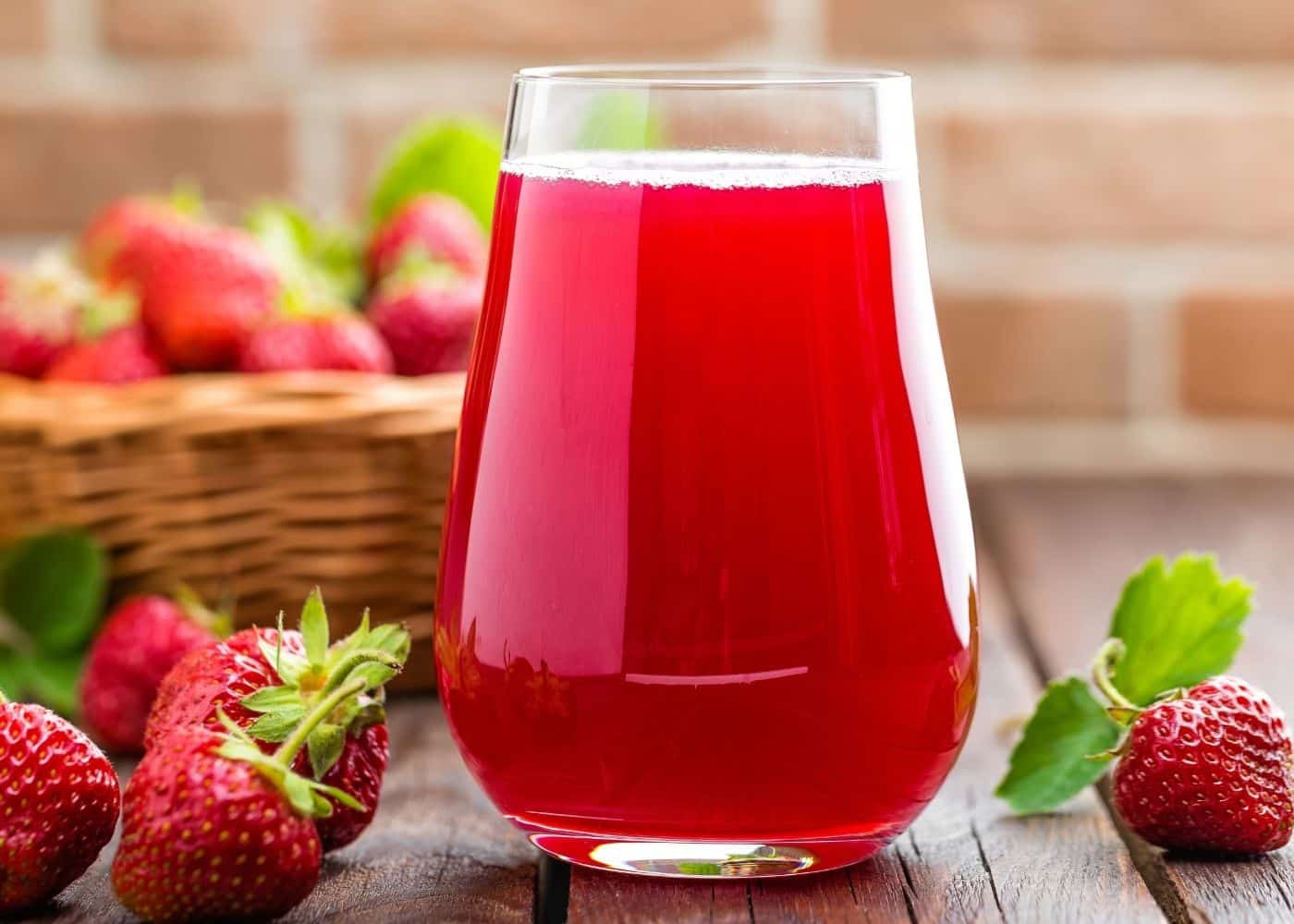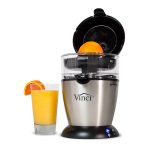Yes, strawberries can be put in a juicer to extract their juice easily. Juicing strawberries is a great way to enjoy their sweet and tangy flavor and benefit from their nutritional content.
Strawberries, with their vibrant red color and sweet aroma, are a popular fruit enjoyed by many. Not only are they delicious, but they also contain a wealth of nutrients. Packed with vitamin c, antioxidants, and fiber, strawberries offer numerous health benefits.
And what better way to savor their goodness than by juicing them? By putting strawberries in a juicer, you can extract the juice from these juicy fruits quickly and conveniently. Juicing strawberries allows you to create refreshing and flavorful beverages that are not only tasty but also nutritious. Whether you enjoy a glass of strawberry juice on its own or use it as an ingredient in smoothies or cocktails, juicing strawberries can enhance your culinary experience. So, grab your juicer, toss in some strawberries, and enjoy the vibrant flavors and health benefits this fruit has to offer.

Credit: www.cleaneatingkitchen.com
What Is A Juicer And How Does It Work?
A juicer is a device that extracts juice from fruits and vegetables, including strawberries. It works by grinding the produce and separating the juice from the pulp, resulting in a nutritious and refreshing drink. Juicing strawberries can be a great way to enjoy their natural flavors and reap their health benefits.
A juicer is a kitchen appliance that serves the primary function of extracting juice from fruits and vegetables. There are different types of juicers available on the market, each with its own unique features and functionalities. Let’s explore what a juicer is and how it works in more detail:
Explanation Of What A Juicer Is And Its Primary Function:
- A juicer is a kitchen appliance specifically designed to extract juice from fruits and vegetables.
- Its main function is to separate the liquid content, or juice, from the solid parts of the produce, such as the pulp, skin, and seeds.
Different Types Of Juicers Available In The Market:
When it comes to juicers, there are several types to choose from, depending on your needs and preferences:
- Centrifugal juicers: These are the most common and affordable juicers. They work by spinning the produce at a high speed while using centrifugal force to separate the juice from the pulp.
- Masticating juicers: Also known as cold press juicers or slow juicers, these machines use a slow and gentle squeezing action to extract juice, preserving more nutrients and enzymes.
- Citrus juicers: As the name suggests, these juicers are specifically designed for citrus fruits like oranges, lemons, and grapefruits. They efficiently extract juice by squeezing the fruits against a rotating cone.
- Twin gear juicers: These advanced juicers utilize two interlocking gears to crush and grind the produce, extracting juice while minimizing oxidation and maximizing nutrient content.
Overview Of The Juicer Components And Their Functions:
A juicer consists of several components that work together to extract juice effectively:
- Feed chute: This is the opening through which you insert the fruits and vegetables into the juicer.
- Blade or auger: Depending on the type of juicer, it can have a blade or an auger that spins, cuts, or crushes the produce to release the juice.
- Strainer or filter: This component separates the pulp and seeds from the extracted juice, ensuring a smooth and pulp-free liquid.
- Juice container: The juice container is where the extracted juice collects for easy pouring and serving.
- Pulp container: This container collects the leftover pulp and fiber that remains after the juice extraction process.
- Motor: The motor powers the juicer, enabling the spinning or squeezing actions required for juice extraction.
A juicer is an essential kitchen appliance that allows you to create fresh and nutritious juice from fruits and vegetables. Understanding the different types of juicers available in the market, as well as their various components and functions, will help you choose the right juicer for your juicing needs.
So, get ready to enjoy delicious and healthy homemade juices with your juicer of choice!
Benefits Of Juicing Strawberries
Juicing strawberries can bring numerous benefits to your health. This nutritious fruit is rich in antioxidants, vitamins, and minerals, which can boost your immune system, improve digestion, and promote healthy skin. Enjoy the refreshing taste and reap the rewards of juicing strawberries.
Highlighting The Nutritional Value Of Strawberries:
- Strawberries are packed with essential nutrients that are beneficial for your overall health and wellbeing.
- Rich in vitamin c, strawberries help boost your immune system and protect against common illnesses.
- Vitamin k found in strawberries promotes bone health and helps with blood clotting.
- The high fiber content in strawberries aids digestion and contributes to maintaining a healthy weight.
- Strawberries are also a great source of antioxidants, including anthocyanins, which help fight free radicals and reduce oxidative stress in the body.
- Additionally, they contain manganese, folate, and potassium, all of which are essential for various bodily functions.
How Juicing Strawberries Enhances Nutrient Absorption:
- Juicing strawberries can make it easier for your body to absorb and utilize the nutrients present in the fruit.
- The juicing process breaks down the cellular structure of strawberries, making the nutrients more accessible.
- The fiber content in whole strawberries can sometimes hinder nutrient absorption, but by juicing them, you eliminate this barrier.
- Removing the fiber allows your body to quickly absorb the vitamins, minerals, and antioxidants present in strawberries.
- Juicing also concentrates the nutrients in a smaller volume, making it easier to ingest a higher quantity of strawberries and reap their benefits.
Discussing The Potential Health Benefits Of Strawberry Juice:
- Drinking strawberry juice regularly can have numerous positive effects on your health.
- The antioxidants in strawberry juice help reduce inflammation and oxidative stress, which are linked to chronic diseases such as heart disease and cancer.
- Strawberry juice may improve cardiovascular health by reducing cholesterol levels and lowering blood pressure.
- The high vitamin c content in strawberry juice promotes collagen production, contributing to healthier skin and strengthening blood vessels.
- The combination of fiber and vitamin c in strawberry juice supports digestive health, preventing constipation and promoting regularity.
- Strawberries contain flavonoids that have been found to support brain health, potentially reducing the risk of age-related declines in cognitive function.
Remember, incorporating freshly juiced strawberries into your daily routine can provide a convenient and delicious way to boost your nutrient intake and support your overall health. So, grab those strawberries and start juicing your way to a healthier lifestyle!
Juicing Vs. Blending: Which Is Better For Strawberries?
Juicing versus blending: which method is more suitable for strawberries? Discover the best way to incorporate strawberries into your drinks and enjoy their sweet and tangy flavor to the fullest.
Understanding The Key Differences Between Juicing And Blending:
- Juicing is the process of extracting the liquid from fruits and vegetables, leaving behind the fiber and pulp. On the other hand, blending involves blending the whole fruit or vegetable, including the fiber and pulp, into a smoothie-like consistency.
- Juicing requires a juicer, while blending can be done with a blender or a food processor.
- Juicing results in a more liquid texture, while blending creates a thicker smoothie.
- Juiced fruits and vegetables may have a longer shelf life than blended ones, as the fiber in blended drinks can make them spoil more quickly.
Pros And Cons Of Juicing Strawberries Compared To Blending:
**juicing strawberries:**
- Pros:
- Juicing allows for easy digestion and absorption of nutrients, as the body doesn’t have to break down the fiber and pulp.
- It provides a concentrated dose of nutrients from the strawberries.
- Juicing can be a refreshing and hydrating way to consume strawberries.
- Cons:
- Juicing removes the fiber from strawberries, which is a valuable component of a healthy diet.
- Without the fiber, the sugar in strawberries can be quickly absorbed by the body, potentially causing blood sugar spikes.
**blending strawberries:**
- Pros:
- Blending retains the fiber in strawberries, which promotes healthy digestion and helps regulate blood sugar levels.
- The fiber in blended strawberries can also help you feel fuller for longer.
- Blending allows for a thicker and more filling drink.
- Cons:
- Blending may result in a slightly less concentrated dose of nutrients from the strawberries compared to juicing.
- The texture of blended strawberries may not be preferred by some individuals.
Examining The Impact On Nutrient Availability In Juiced Vs. Blended Strawberries:
When it comes to the impact on nutrient availability, there are a few things to consider:
- Juicing strawberries:
- While juicing extracts the liquid and nutrients from strawberries, it also removes most of the fiber. This means that the nutrients are readily available for the body to absorb, but the lack of fiber may impact how the sugar in strawberries is metabolized.
- Blending strawberries:
- Blending retains the fiber in the strawberries, which slows down the absorption of sugar and helps regulate blood sugar levels. The fiber also promotes healthy digestion. However, blending may slightly decrease the concentration of nutrients compared to juicing.
Juicing strawberries provides a concentrated dose of nutrients but removes the fiber, while blending retains the fiber but may reduce the overall concentration of nutrients. Both juicing and blending have their pros and cons, so choosing between them depends on personal preferences and health goals.
How To Prepare Strawberries For Juicing
Discover how to prepare strawberries for juicing and find out if you can put them in a juicer. Our step-by-step guide will help you get the most out of your strawberries, ensuring a refreshing and delicious juice every time.
Proper Washing Techniques For Strawberries:
- Rinse the strawberries under cold running water to remove any dirt or debris.
- Gently pat the strawberries dry with a paper towel or clean cloth.
- Fill a bowl with a mixture of water and white vinegar (1 part vinegar to 3 parts water).
- Submerge the strawberries in the vinegar solution for a few minutes.
- Swirl the strawberries around in the solution to ensure all surfaces are cleaned.
- Remove the strawberries from the solution and rinse them thoroughly under cold running water.
- Gently pat the strawberries dry before proceeding with the next step.
Removing The Stems And Any Blemishes:
- Hold the strawberry in one hand and grasp the stem firmly near the top.
- Use a sharp knife or your fingers to carefully twist and pull the stem out of the strawberry.
- Inspect the strawberry for any blemishes or bruises.
- If you come across any blemishes, use a paring knife to carefully remove the affected area.
- Be cautious not to remove too much of the strawberry flesh.
Slicing Or Chopping The Strawberries For Juicing:
- Decide whether you prefer sliced or chopped strawberries for your juice.
- For sliced strawberries, place the strawberry on a cutting board and use a sharp knife to cut thin slices.
- For chopped strawberries, cut the strawberry in half and then into smaller pieces.
- Make sure to remove any remaining green stem from the slices or chopped pieces.
- Repeat the process for the remaining strawberries.
- For better juicing results, aim for uniform-sized slices or pieces.
- Proceed with adding the prepared strawberries to your juicer to extract the delicious juice.
Remember to always use fresh and well-washed strawberries for the best juicing experience. By following these simple steps, you’ll have perfectly prepped strawberries ready for your juicer, ensuring a refreshing and nutritious glass of strawberry juice.
Best Practices For Juicing Strawberries
Discover the best practices for juicing strawberries and learn if you can put them in a juicer. Find out how to maximize flavor and nutrition while avoiding common mistakes. Enjoy the refreshing taste of homemade strawberry juice with these expert tips.
Recommended Juicing Methods For Strawberries:
- Slicing method: Start by washing the strawberries thoroughly. Remove the stems and hulls before slicing them into smaller pieces. This method is perfect if you prefer a more textured juice.
- Blending method: Similar to making a smoothie, blend the whole strawberries with a small amount of liquid, such as water or juice. This method ensures a thicker consistency, retaining the fiber from the fruit.
Tips For Achieving Maximum Juice Extraction:
- Room temperature: Use strawberries that are at room temperature. Cold strawberries may yield less juice and reduce the overall flavor.
- Gentle pressure: Apply mild pressure when juicing the strawberries to avoid damaging the seeds, which can add a bitter taste to the juice.
- Slow juicer preferred: Consider using a slow juicer instead of a centrifugal juicer. Slow juicers extract juices more efficiently without generating excessive heat, which can impact the taste and nutritional value of the juice.
Incorporating Strawberries Into Juice Recipes For Optimal Flavor:
- Berry bliss: Combine strawberries with blueberries and raspberries for a burst of berry goodness. Add a splash of lemon juice to balance the sweetness.
- Tropical twist: Enhance the flavor by combining strawberries with pineapple, mango, and a hint of fresh mint. This combination provides a refreshing and tropical twist to your juice.
- Green delight: Add strawberries to your favorite green juice recipe. The sweetness of strawberries complements the earthiness of greens, creating a well-balanced blend.
Remember, experimentation is key when it comes to finding your perfect strawberry juice recipe. Play around with different combinations and ratios to suit your taste preferences. Enjoy the sweet and tangy goodness of freshly juiced strawberries!
Potential Challenges Of Juicing Strawberries
Juicing strawberries can present potential challenges due to their high water content and delicate texture. However, by using a slow juicer or blending with other fruits, you can still enjoy the rich flavor and nutritional benefits of strawberries in your homemade juice.
Addressing The Issue Of Clogging In Juicers Due To Strawberries:
- Strawberries have a high water content and are often considered soft fruits, making them prone to clogging in juicers. Here’s how you can address this challenge:
- Chop the strawberries into smaller pieces before juicing them to prevent clogging.
- Alternate between feeding strawberries and harder fruits or vegetables into the juicer to help push the softer pulp through the juicer.
- Clean the juicer immediately after use to prevent any residual pulp from further clogging the machine.
Ways To Prevent Oxidation And Extend The Shelf Life Of Strawberry Juice:
- Oxidation can cause the strawberry juice to lose its color and nutritional value over time. Follow these tips to prevent oxidation and extend the shelf life of your strawberry juice:
- Add a small amount of lemon juice to the strawberry juice. The citric acid in lemon helps prevent oxidation by inhibiting browning.
- Store the strawberry juice in airtight containers to minimize exposure to oxygen. This will help retain its freshness and flavor.
- Refrigerate the strawberry juice as soon as possible to slow down the oxidation process. It is best consumed within 24 to 48 hours to retain its taste and nutritional benefits.
Handling Potential Issues With The Texture Or Consistency Of Strawberry Juice:
- While juicing strawberries, you might encounter some challenges related to texture or consistency. Here’s what you can do to address these issues:
- Strain the strawberry juice through a fine mesh sieve or cheesecloth to remove any large pieces of pulp or seeds, resulting in a smoother texture.
- If the strawberry juice appears too thick, you can dilute it with a small amount of water or another liquid of your choice to achieve the desired consistency.
- Consider blending the strawberries instead of using a juicer if you prefer a thicker, more pulp-filled texture for your juice.
Remember, juicing strawberries can be a delightful way to enjoy their sweet and tangy flavors while reaping their health benefits. By addressing the potential challenges of clogging, preventing oxidation, and managing texture-related issues, you can ensure a delicious and refreshing strawberry juice experience.
Cheers to a healthier lifestyle!
Strawberry Juice Recipes And Variations
Strawberry juice recipes and variations are a delightful way to utilize fresh strawberries. Discover how you can easily incorporate these juicy fruits into your daily juicing routine.
Strawberries are not only delicious but also incredibly versatile when it comes to juicing. Their vibrant red color and sweet, tangy flavor make them a popular choice for creating refreshing and nutritious juices. In this section, we will explore various strawberry juice recipes and the exciting ways you can use this versatile ingredient in your beverages and dishes.
So grab your juicer and get ready to unleash the amazing potential of strawberries!
Sharing Popular Strawberry Juice Recipes:
- Classic strawberry delight: Blend fresh strawberries, a splash of lemon juice, and a touch of honey for a delightful and refreshing juice.
- Strawberry watermelon fusion: Combine juicy watermelon chunks with ripe strawberries for a vibrant and hydrating juice bursting with flavors.
- Strawberry pineapple paradise: Blend fresh strawberries with chunks of tangy pineapple for a tropical twist on strawberry juice.
Exploring Variations By Combining Strawberries With Other Fruits Or Vegetables:
- Strawberry-banana blast: Create a creamy and fruity concoction by blending strawberries with ripe bananas for a nutrition-packed juice.
- Strawberry-orange zest: Add a zing to your strawberry juice by combining it with tangy oranges, creating a vibrant and vitamin c-rich drink.
- Strawberry-cucumber refresher: Boost your hydration levels by blending juicy strawberries with crisp cucumber slices for a refreshing and cooling juice.
Highlighting Creative Ways To Use Strawberry Juice In Drinks And Dishes:
- Strawberry lemonade: Mix strawberry juice with freshly squeezed lemon juice and a hint of sugar for a sweet and tangy summer cooler.
- Strawberry mojito mocktail: Combine strawberry juice with lime juice, fresh mint leaves, and sparkling water for a refreshing alcohol-free version of the classic cocktail.
- Balsamic strawberry salad dressing: Drizzle strawberry juice, balsamic vinegar, and olive oil over a mixed green salad for a unique and flavorful dressing.
Now you have a collection of fabulous strawberry juice recipes and creative ideas for incorporating strawberry juice into your drinks and dishes. Experiment with these recipes, explore new combinations, and enjoy the vibrant flavors that strawberries bring to your table.
Cheers to the goodness of strawberries in every sip and bite!
Cleaning And Maintenance Of Juicers When Juicing Strawberries
Juicing strawberries? Keep your juicer in top shape with proper cleaning and maintenance. Discover the best practices to ensure efficient juicing without compromising the performance of your juicer.
Can You Put Strawberries In A Juicer?
Juicing strawberries is a delicious way to enjoy their sweet and refreshing flavor while reaping the health benefits they offer. However, when it comes to cleaning and maintaining your juicer after juicing strawberries, it’s important to follow proper steps to ensure its longevity and optimal performance.
In this section, we will discuss the importance of proper cleaning and maintenance, provide steps to clean a juicer after juicing strawberries, and share tips for troubleshooting common juicer issues related to strawberries.
Importance Of Proper Cleaning And Maintenance For Juicer Longevity:
Properly cleaning and maintaining your juicer is vital for its longevity and continued performance. Here’s why:
- Prevents residue buildup: Strawberries can leave behind pulp, juice, and seeds that can accumulate over time and result in clogged parts. Regular cleaning ensures that these residues do not hinder the juicer’s functionality.
- Maintains hygiene: Thoroughly cleaning your juicer after each use eliminates any potential bacteria or mold growth, ensuring that your next batch of strawberry juice is safe to consume.
- Enhances performance: By keeping your juicer clean and well-maintained, it can operate at its best. This ensures efficient juicing, allowing you to extract the maximum amount of juice from your strawberries.
Steps To Clean A Juicer After Juicing Strawberries:
Follow these simple steps to clean your juicer after juicing strawberries:
- Unplug the juicer: Before starting the cleaning process, ensure that the juicer is unplugged to avoid any accidents.
- Disassemble the juicer: Remove all detachable parts such as the juicing chamber, blade, strainer, and pulp container. Refer to your juicer’s manual for specific instructions on disassembly.
- Rinse with warm water: Rinse all parts under warm water to remove any visible residue.
- Use a brush or sponge: For stubborn pulp or juice stains, gently scrub the parts with a brush or sponge. Be cautious not to damage any delicate components.
- Clean hard-to-reach areas: Pay attention to hard-to-reach areas such as crevices and corners of the juicing chamber. Use a small brush or toothbrush to ensure a thorough clean.
- Dry all parts: After cleaning, thoroughly dry all the juicer components before reassembling. Moisture can lead to mold or damage the juicer’s electrical parts.
- Reassemble the juicer: Once dry, reassemble the juicer by putting the parts back together, ensuring they fit snugly.
- Wipe the exterior: Use a damp cloth to wipe the juicer’s exterior, removing any spills or stains.
- Store properly: Store your juicer in a clean and dry place, ready for future use.
Tips For Troubleshooting Common Juicer Issues Related To Strawberries:
Sometimes, you may encounter specific problems when juicing strawberries. Here are some tips to help you troubleshoot these common issues:
- Clogging: If your juicer frequently clogs while juicing strawberries, try cutting them into smaller pieces or alternate with other fruits or vegetables to avoid overloading the juicer.
- Reduced juice yield: If you’re not getting as much juice as expected from your strawberries, check if the strainer or blade is clogged with pulp. Clean them thoroughly to ensure optimal juice extraction.
- Uneven juicing: To achieve a more consistent juice texture, mix strawberries with other juicy fruits or add a small amount of water. This helps create a smoother blend.
- Noisy operation: If your juicer becomes unusually noisy when juicing strawberries, it may indicate a worn-out or misaligned part. Refer to your juicer’s manual for guidance on troubleshooting or contact the manufacturer for assistance.
By following these cleaning and maintenance steps and troubleshooting tips, you can ensure that your juicer remains in excellent condition while enjoying the vibrant flavors of freshly juiced strawberries. Happy juicing!
Concluding Thoughts
Putting strawberries in a juicer is possible and can result in a delicious, refreshing drink. The juicer can extract the juice from the strawberries, providing a convenient and nutrient-rich option. Enjoy the natural sweetness of strawberries in your homemade juice.
Juicing strawberries can be a delightful way to enjoy the freshness and flavors of this vibrant fruit. In this blog post, we have explored the benefits and challenges of juicing strawberries, and now it’s time for some concluding thoughts. Let’s recap the advantages and potential obstacles of incorporating strawberries into your juicing routine, and encourage you to experiment and embrace the versatility of strawberry juice.
Recap Of The Benefits And Challenges Of Juicing Strawberries:
- Nutritional powerhouse: Strawberries are packed with essential vitamins, minerals, and antioxidants that can provide numerous health benefits. From boosting your immune system to promoting heart health, strawberry juice can be a nourishing addition to your diet.
- Refreshing taste: The natural sweetness and refreshing flavor of strawberries can add a delightful twist to your juices. Their vibrant red color also adds visual appeal, making your drinks both tasty and visually pleasing.
- Versatile ingredient: Strawberry juice can be enjoyed on its own or used as a base to create endless flavor combinations. It pairs well with various fruits, vegetables, and even herbs, allowing you to get creative and customize your juicing experience.
- Delicate texture: While strawberries can be easily juiced, their delicate texture means that they need to be handled with care. Ensure that you remove the stems and thoroughly rinse the berries before juicing to avoid any unwanted grittiness.
- Limited juice yield: Due to their high water content, strawberries may not yield as much juice as other fruits. However, their rich flavor compensates for the lower quantity, making it worth the effort.
Encouragement To Experiment And Enjoy The Versatility Of Strawberry Juice:
- Mix and match: Don’t be afraid to combine strawberries with other fruits and vegetables to create unique flavor profiles. From strawberry-banana blends to strawberry-mint concoctions, there are endless possibilities to discover.
- Enhance with herbs and spices: Experimenting with herbs like basil or spices like ginger can elevate the taste of your strawberry juice. These additions can provide an extra kick of flavor and offer their own health benefits.
- Freezing options: If you have an abundance of strawberries or want to enjoy their freshness for a longer duration, consider freezing them for future use in smoothies or juices. This way, you can savor the taste of summer strawberries all year round.
- Try different juicing methods: Apart from using a traditional juicer, you can also explore alternative methods like blending or mashing strawberries and straining the pulp to enjoy their juice. Each technique offers a unique texture and taste, allowing you to find your preferred method.
- Enjoy it fresh: Strawberry juice is best enjoyed immediately after juicing to savor its vibrant flavors and optimal nutritional benefits. So grab your juicer, pick some ripe strawberries, and indulge in this refreshing and healthy treat.
With these thoughts in mind, it’s time to embark on your strawberry juicing journey. Remember to experiment, savor the flavors, and embrace the versatility of strawberry juice. Happy juicing!
Frequently Asked Questions On Can You Put Strawberries In A Juicer
Can Strawberries Go In The Juicer?
Yes, strawberries can be put in a juicer. Juicing strawberries is a great way to enjoy their sweet and refreshing taste.
Can You Juice Berries In A Juicer?
Yes, you can juice berries in a juicer.
What Should You Not Put In A Juicer?
Avoid putting certain ingredients in a juicer to prevent damage and ensure optimal results. Hard fruits with pits, such as peaches and plums, should be pitted before juicing. Seeds from fruits like apples or grapes should also be removed. Citrus fruit peels can make the juice taste bitter, so it is best to remove them.
Additionally, juicers are not designed to process thick substances like avocado or banana, so avoid adding these to your juicer. Hard vegetables like beets or carrots can strain the motor, so it is advised to cut them into smaller pieces before juicing.
Lastly, avoid putting herbs or fibrous greens like wheatgrass directly into the juicer, as they can clog the machine. Instead, wrap them in a leafy vegetable before juicing. By following these guidelines, you can effectively use your juicer without causing any damage.
What Are The Benefits Of Juicing Strawberries?
Juicing strawberries offers several benefits. Strawberries are rich in vitamins, antioxidants, and fiber. These nutrients support overall health and well-being. Drinking strawberry juice can boost the immune system, improve digestion, and promote weight loss. The antioxidants in strawberries help protect against chronic diseases and reduce inflammation.
Consuming strawberry juice may also improve heart health and lower the risk of conditions like high blood pressure and stroke. Furthermore, strawberries contain compounds that can enhance cognitive function and prevent age-related mental decline. As a tasty and refreshing choice, strawberry juice is a convenient way to increase fruit intake and enjoy its many health benefits.
Incorporating juiced strawberries into your diet can be a delicious and nutritious addition to a healthy lifestyle.
Conclusion
Juicing strawberries can be a delicious and nutritious addition to your daily routine. Whether you choose to use a traditional juicer or a blender, the process is simple and the results are fantastic. By removing the seeds and adding a hint of sweetness, you can create a refreshing beverage that is bursting with flavor.
The antioxidants present in strawberries can provide numerous health benefits, such as reducing inflammation and supporting heart health. Additionally, the high vitamin c content of strawberries can boost your immune system and promote healthy skin. So, don’t hesitate to experiment with juicing strawberries and enjoy the incredible taste and health benefits that come with it.
Cheers to a healthy lifestyle and happy juicing!

Freda is a passionate foodie and kitchen gadget enthusiast. With over 10 years of experience in the culinary industry, Freda brings her expertise in testing and reviewing kitchen gadgets.




